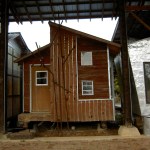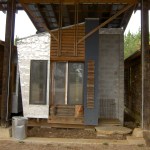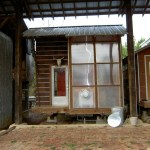One of my heroes is Sam Mockbee, a socially committed architect who left a commercial practice to teach at Auburn University and co-founded, with fellow professor D. K. Ruth, the Rural Studio, dedicated to bringing sophisticated, artful architecture to residents of poor, rural parts of Alabama. “Everybody wants the same thing,” Mockbee said, “not only a warm, dry room, but a shelter for the soul.” He took his students to rural communities and taught them how to work with local residents to design and build houses and community buildings. The resulting structures are striking, witty, and inventive, using materials ingeniously and to great effect.
A few years ago, my work took me to Montgomery, Alabama, so I stayed on a couple of days, rented a car, and drove out to Hale County, Alabama, where the Rural Studio has done much of its work. Hale County was the setting for Let Us Now Praise Famous Men, the 1941 classic study of rural poverty by James Agee and Walker Evans. It’s still pretty poor.
On my way I stopped in Newbern, Alabama, where the studio is headquartered. Young people were putting together a barbecue but let me wander around the houses they had built and lived in.
The houses sat cheek by jowl under a long common roof; the buildings all faced south and used a wild assortment of materials–cardboard, shredded paper, concrete blocks, license plates, sheet metal, wood, glass, and concrete.



I ate dinner at a Mexican restaurant–cheap, busy, and not bad–then walked back the house by a basketball court where two sets of girls, one black, one white, played apart from each other in the dying sun.
The next morning it was raining furiously. My host left for work and her maid, a black woman I guessed in her late forties, a little younger than I but I couldn’t be sure, made me breakfast and stayed and talked with me as I ate. It rained and rained and we talked for a couple of hours. At one point I told her about the two sets of basketball players and asked her when she thought relations between the two races would be healed and she shook her head in disbelief and said, “it will take generations.” She lived with a shiftless man who sat around the house being nasty and I urged her to leave him and gave her $20.
When the rain lifted I drove west to Akron and the nearly invisible Mason’s Bend. The road to Mason’s Bend went through pastureland and these beautiful cows came up to me when I stood by
and these beautiful cows came up to me when I stood by
their fence.
 The Mason’s Bend buildings were beautiful, if neglected. The chapel, which used recylced auto windows for the tower and clay for the walls, was overgrown with weeds but still felt somehow hallowed. The houses, quirky and interesting, seemed too personal to post here.
The Mason’s Bend buildings were beautiful, if neglected. The chapel, which used recylced auto windows for the tower and clay for the walls, was overgrown with weeds but still felt somehow hallowed. The houses, quirky and interesting, seemed too personal to post here.
From there I went to Akron, Alabama where I had my sights on a Rural Studio version of a community building. As it happened, some men were moving a printing press into the building. A man who introduced himself as Mr. Kennedy was setting up a print shop. He and the others were hauling in some antique presses. You can see why people fall in love with machines. Then, too as Kennedy points out in the short video, Proceed and Be Powerful, if you own a press you can say whatever you want.
A man who introduced himself as Mr. Kennedy was setting up a print shop. He and the others were hauling in some antique presses. You can see why people fall in love with machines. Then, too as Kennedy points out in the short video, Proceed and Be Powerful, if you own a press you can say whatever you want.
 Today marks the death of the brilliant polymath who discovered that, “Bottomless wonders spring from simple rules, …repeated without end.” Click on the fractal to the right for a dizzying (10-minute) immersion in fractals. Benoit Mandelbrot (Benjamin Almondbread), growing up under the Occupation of France knew every day could be his last, he said, so he dreamed big–and discovered fractal geometry, applying the computer some very old math problems. He talks about his life and his discoveries in this TED talk.:
Today marks the death of the brilliant polymath who discovered that, “Bottomless wonders spring from simple rules, …repeated without end.” Click on the fractal to the right for a dizzying (10-minute) immersion in fractals. Benoit Mandelbrot (Benjamin Almondbread), growing up under the Occupation of France knew every day could be his last, he said, so he dreamed big–and discovered fractal geometry, applying the computer some very old math problems. He talks about his life and his discoveries in this TED talk.:






 and these beautiful cows came up to me when I stood by
and these beautiful cows came up to me when I stood by  The Mason’s Bend buildings were beautiful, if neglected. The chapel, which used recylced auto windows for the tower and clay for the walls, was overgrown with weeds but still felt somehow hallowed. The houses, quirky and interesting, seemed too personal to post here.
The Mason’s Bend buildings were beautiful, if neglected. The chapel, which used recylced auto windows for the tower and clay for the walls, was overgrown with weeds but still felt somehow hallowed. The houses, quirky and interesting, seemed too personal to post here. A man who introduced himself as Mr. Kennedy was setting up a print shop. He and the others were hauling in some antique presses. You can see why people fall in love with machines. Then, too as Kennedy points out in the short video,
A man who introduced himself as Mr. Kennedy was setting up a print shop. He and the others were hauling in some antique presses. You can see why people fall in love with machines. Then, too as Kennedy points out in the short video,